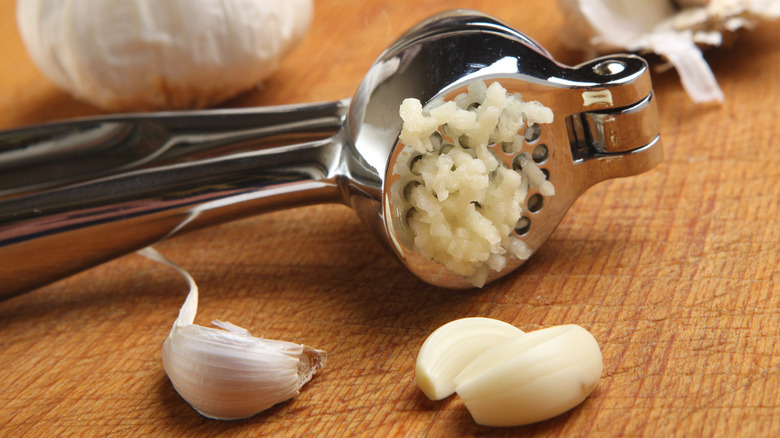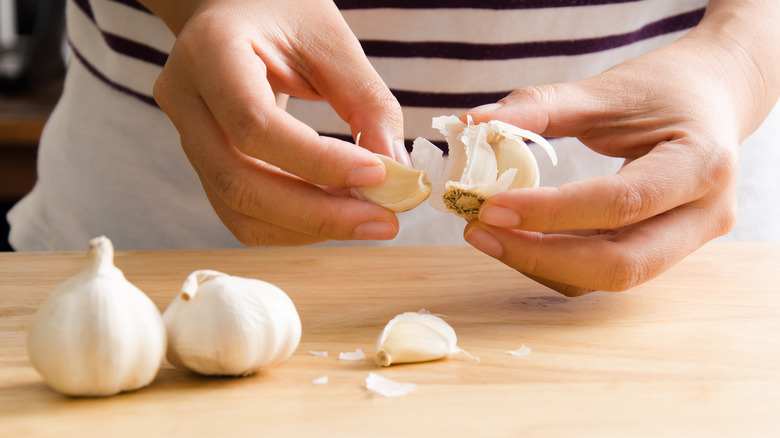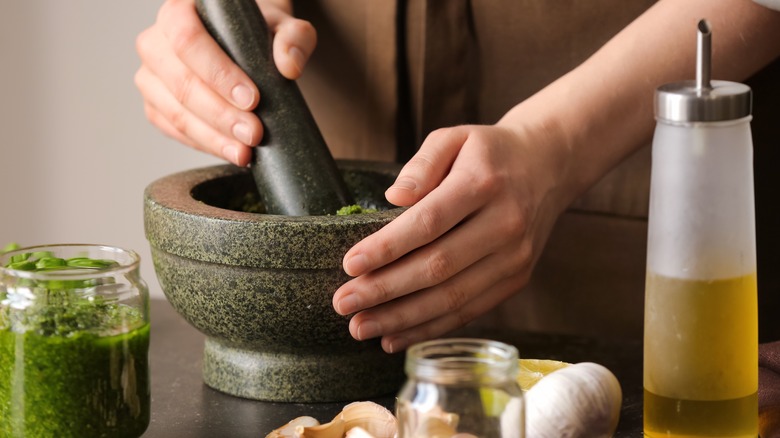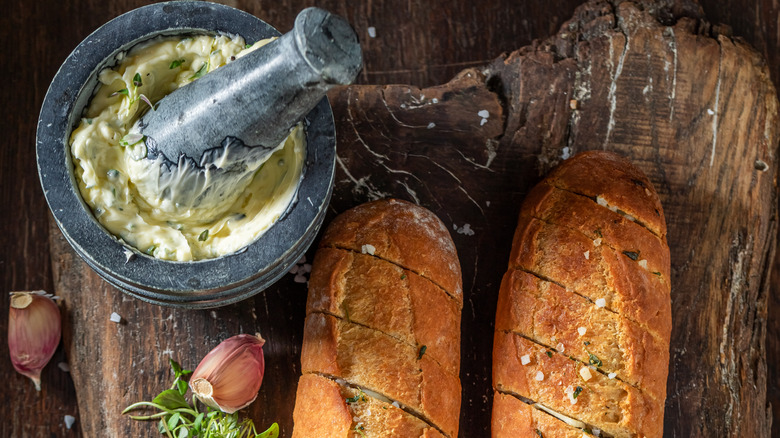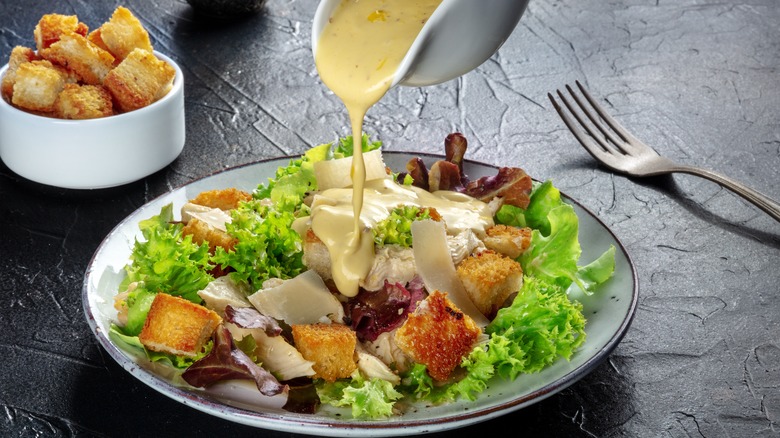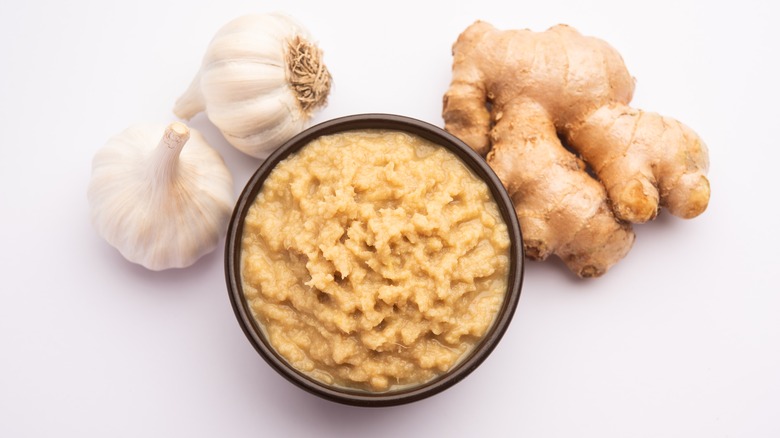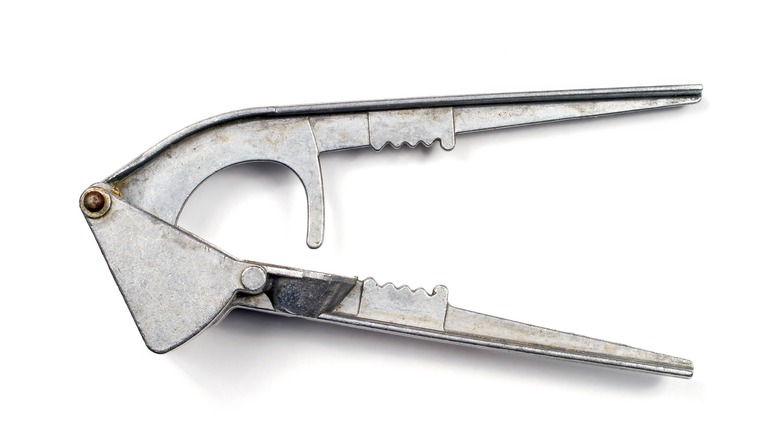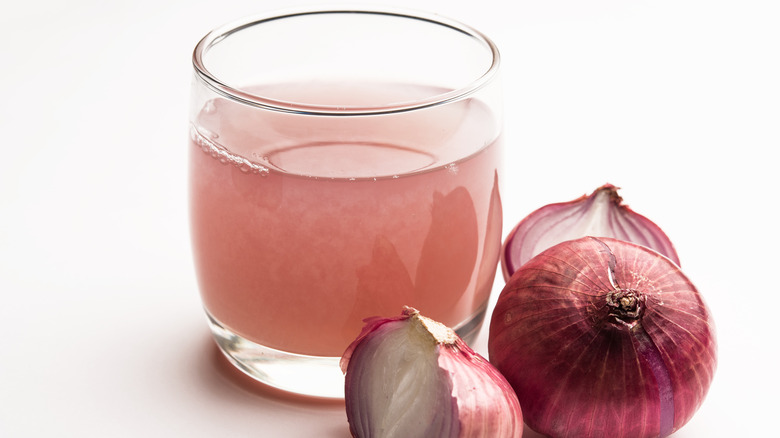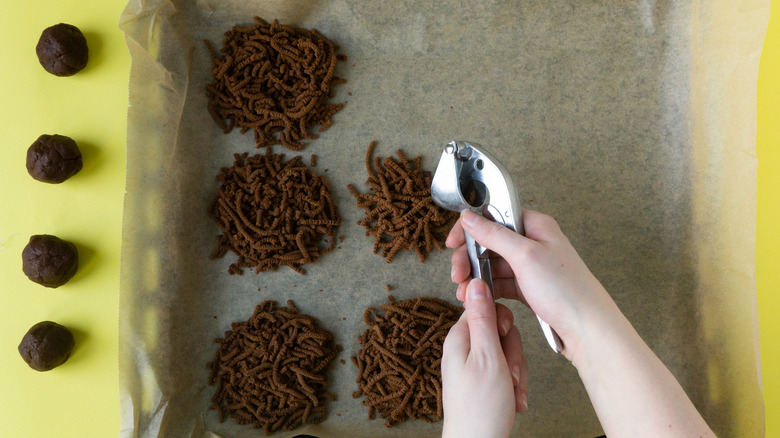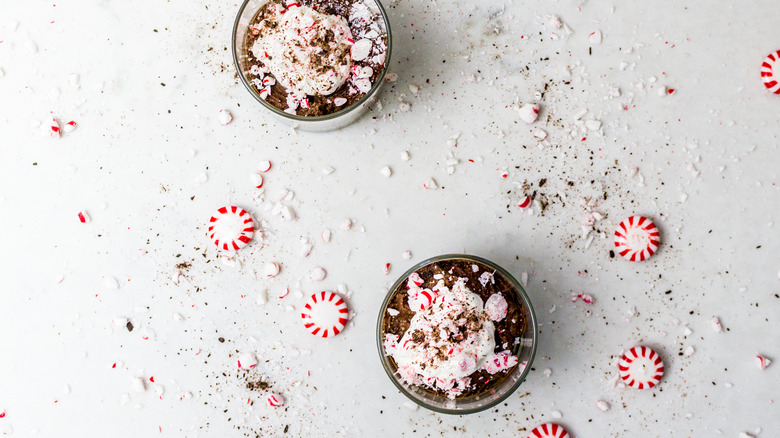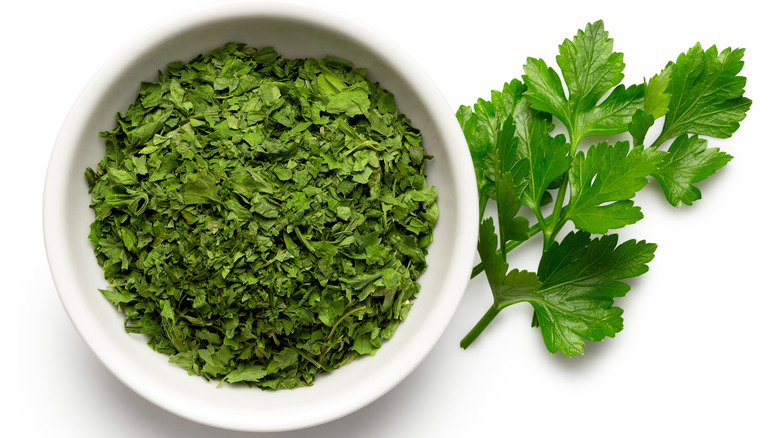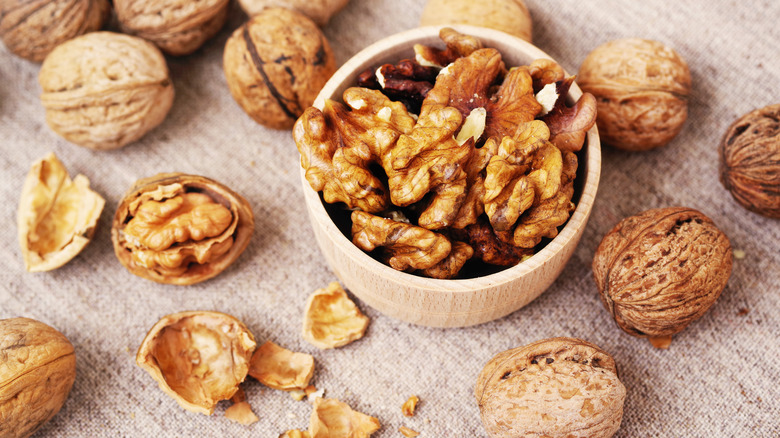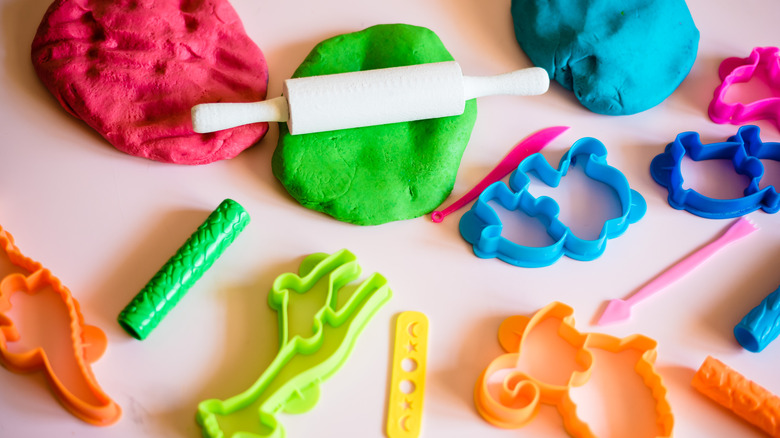The 12 Absolute Best Uses For Your Garlic Press
Having the right tool for the job can be a real-time-saver in the kitchen. When it comes to mincing garlic quickly, there is no better tool than the garlic press. For those dishes where you need a strong garlic flavor, minced garlic will easily meld with other ingredients creating smooth, well-balanced sauces, pastes, and marinades. If you want a milder taste, you could use an oven-roasted garlic recipe first and then turn to use the press, but no matter how you use garlic in the kitchen, you're going to want one of these tools around.
By placing a clove of garlic within the press chamber, you are literally crushing it through small holes that allow even-sized pieces to emerge. Along with the small pressed pieces, the garlic's oils are released, resulting in an intensely flavorful mound of garlic with little waste (via MasterClass). This allows for better incorporation in quickly cooked dishes, like stir-fries, and it also aids in a shorter cooking time and a smoother taste for garlic overall. Larger chopped chunks won't cook through as thoroughly as minced, leaving a more raw and pungent flavor to your garlic.
But there is so much more this handy kitchen tool can do. In a pinch, it is a great stand-in for your chef's knife, ricer, or juicer. Here are some creative tips for other ways to use your garlic press that will save you time and energy.
Remove garlic skins quickly
Why get your hands sticky and smelly from peeling garlic skins? According to America's Test Kitchen, with one gentle push, you can easily remove the skin on a garlic clove. Simply place a clove inside the press and lightly squeeze until you hear the skin crack. Remove the clove, and the skin will easily peel off, leaving you with the whole clove intact. Or, in one simple squeeze, you can remove the skin of the clove and mince it at the same time. The skins will remain separated in the chamber.
It's a great tool if you're making garlic confit or any other dish requiring whole cloves, like flavored oils. Once you've skinned the garlic cloves, submerge them in oil to add a pungent flavor. Just make sure to store the oil in the refrigerator once you've added the garlic. The University of California Agriculture and Natural Resources safety guidelines state that even when cold, an oil and garlic combo will keep for no more than 4 days. If you freeze it, it will keep for a few months.
Don't throw out those garlic skins. They still pack a lot of flavors. Just add them to your stocks. They'll strain out with everything else once the flavor has been extracted. You can also add the skins along with fresh herbs when using a spice sachet or if you're making a bouquet garni.
Replace your bulky mortar and pestle with a garlic press
Crushing ingredients with a mortar and pestle takes time and strength. But cooking also takes a lot of effort. Why work so hard now that you have a garlic press? Many classic condiments, like aioli, require the use of a mortar and pestle to crush the garlic into a paste. If you're not thorough, you can end up with chunky garlic bits that will ruin the texture of your dish. Ultimately when making an aioli, you want a thick, creamy texture. Your garlic press will help avoid all unwanted chunks. Just mix the pressed garlic with salt and lemon juice. Start whisking, adding oil very slowly to allow the ingredients to emulsify.
According to Britannica, aioli is a classic sauce with roots in Mediterranean cuisine widely used along the coastal regions of Spain, France, and Italy. Aioli is a great substitute for mayonnaise. It has the consistency of mayonnaise but is made with garlic and olive oil, while mayonnaise is made with canola oil and egg yolks. It is often used as a dipping sauce for vegetables, a condiment on burgers, or spread over a piece of cooked salmon. But what's to stop you from using it to dip your French fries, drizzle over your tacos, or spoon out over your crab cakes? If you're a garlic lover, it's a great condiment to have on hand.
Flavor your butter
Rather than smearing big chunks of garlic on top of buttered bread, you might consider making a compound garlic butter. The New York Times suggests combining garlic with butter to create a smooth topping that is infused with characteristically pungent flavor, or, as the French would call this, a beurre à la bourguignonne.
Use your garlic press to crush cloves of garlic into a paste. Mix it well with softened butter and voilá; you have garlic butter. Thanks to your garlic press, the butter will be smooth and easily spreadable on French bread, croutons, naan, or any bread of your choice. Use a tablespoon of the compound butter to finish a grilled steak, or melt some to use as a basting sauce for fish.
You can also use your garlic press to create other compound butter. Squeeze some olives through your garlic press to create a tangy olive butter. Or maybe you have a bit of a sweet tooth. Use your press to crush toasted pecans and add a bit of maple syrup to your softened butter to make a spread for French toast or pancakes. Even strawberries crush well for sweet butter. Just drain the juice out before adding it to your spread.
Enhance flavors in dressings, marinades, and sauces
Use a press to crush the garlic cloves if you want to add some zest to your salad dressings or marinades. You won't lose any of the intense flavors, and the small pieces will mix well with oils, vinegar, or soy sauce.
You can also use the press to crush anchovies for a classic Caesar salad dressing. This allows the garlic and anchovies to blend easily with the other ingredients. Mix both with salt, lemon juice, Dijon mustard, and egg yolks, and slowly add oil to create a creamy dressing.
Add minced garlic to give your marinades an extra punch. While the marinade tenderizes the meat, the garlic enhances the flavor. Minced garlic is a delicious ingredient paired with oils, vinegar, yogurt, broths, herbs, citrus, or wine-based marinades. It is hard to imagine a tomato-based sauce without garlic, but if you want to tame some of the kick of crushed garlic, it is best to sauté the minced garlic in oil for a minute or two to bring out the sweetness. The next step is to figure out how to bottle that sublime smell in your kitchen.
Create pastes
Use your garlic press for ginger and garlic to create a classic base for many Southeast Asian dishes from India to the Sichuan province. Peel and cut the ginger into garlic clove-sized pieces and crush them, as you would garlic. Mix with salt and vinegar to create a simple paste.
In China, one of the most widely-eaten cuisines is Sichuan (via China Highlights). At the base of many Sichuan dishes are a version of the Holy Trinity; garlic, ginger, and scallions. Like the respected tradition of bell pepper, onion, and celery used in New Orleans cooking or the French mirepoix of onion, celery, and carrot, a garlic-ginger paste with scallions is the first step in creating the piquant flavors behind dishes like kung pao chicken, dan dan noodles, or simple stir fry recipes.
In India, according to The Indian Express, many cooks keep a jar of garlic-ginger paste on hand for easy use. Simply store the paste in the refrigerator for a week or two in an airtight container, or use a small ice cube tray to make individual portions of paste and store them in the freezer for up to six months. It is used as the base for everything from biryanis to curries.
Pit and crush olives
Depending upon the style of garlic press you have, it may have additional features. A vintage-style press can actually be used to pit olives. Older or specialized models of garlic presses have a small, separate cup to hold the olive and a tiny "finger" that forces out the pit leaving the olive intact and without a hard stone. It's perfect for making a tapenade — you can pit your olives and then press the flesh through the press extruder. While you're at it, press through some of the other tapenade ingredients, like garlic, capers, and anchovies.
There's nothing worse than taking a big bite of cherry pie only to break a tooth on a cherry pit. Use the press to pit cherries for pies. The cherries will maintain their round shape and be evenly pitted. Or once pitted, you can rough chop cherries for dessert, garnishes, and jams.
Save the pits and use them to flavor vinegar. Or, pit the cherries and then use the press to crush the fruit, separating the skins from the juice.
Use your press as a mini-juicer
When you think of refreshing beverages, we doubt that onion juice comes to mind. But did you know that onion juice has medicinal purposes? Onions are not only crowded with antioxidant and anti-inflammatory traits but are also a great source of vitamins C, B1, and B6, as well as folic magnesium and phosphorus (via Healthline). According to The Journal of Dermatology, some studies suggest that onion juice can improve the loss of hair in some people if applied to the scalp. Use your press to squeeze small pieces of onion, and watch as the juice separates from the pulp.
The garlic press is also useful for juicing small fruits. Although you can eat the skin of a kumquat, not everyone wants to. If you're looking for that sweet-tart citrus bite without any skin or pith, just squeeze your kumquats using your garlic press. The juice is a great source of vitamin C, and it's a nice twist to use kumquat juice in a cocktail rather than orange or grapefruit.
Use your garlic press as a mini-ricer
Here's a clever use for the garlic press — use it as a mini-ricer. Take chocolate truffles and squeeze them through the garlic press to make nest cookies. Sometimes cookie recipes call for the use of an extruder, but who has one lying around? Your trusty garlic press can come to the rescue. As the dough pushes through the small holes of the press, short strings will eject, allowing you to pile them on top of each other to create a nest. One tip — make sure the dough is cold before using the press.
The press can help to create interesting designs for cakes. Round some colored fondant into balls, then squeeze it through the press. Green short strings can be used for grass, red can be used for a character's hair, and blue can be used to suggest the movement of the ocean.
Are you tired of always sprinkling parmesan on your salads? How about using your garlic press to extrude mozzarella balls? Pressing the cheese through the small holes creates even, stringy pieces. Lightly sprinkle them on top of your salads for a surprising twist.
Garnish your desserts
With so many baking competition shows on television to inspire our inner pastry chef, it seems downright lazy not to try to at least decorate desserts with some finesse. One idea — kick up your cupcakes with some crushed candy kernels. Use your garlic press to crush hard candies into small pieces. Add some peppermint bits to your Christmas desserts, or sprinkle some butterscotch chips on top of a piece of molten chocolate cake. Not only do the candy bits add a nice colorful touch, but they also bring textural crunch to every bite.
You've probably heard of an everything bagel. Why not have an everything cookie or brownie? Use softer candies, like caramels and taffy, to extrude small pieces with your garlic press. They will be a surprising addition to your favorite baked treats.
How about adding a bit of a sweet citrus zing to your tea? Use your press to crush lemon drops or orange Life Savers as an alternative to sugar. The candy pieces will melt quickly, turning an ordinary cup of tea into the perfect dessert pairing.
Crush herbs and spices with your garlic press
Some herbs can be hard to chop by hand, leaving you with uneven or mushy pieces. Use a garlic press for fresh herbs like parsley and mint to get an even cut. Roll the individual leaves together to fill the press chamber. Small, even pieces will emerge as the leaves are pushed through the holes. Place them at the ready in small bowls for garnishes or use them in salad dressings.
The press is also a good tool for crushing whole spice seeds, like peppercorns, cumin, and coriander (via The Oregonian). Since whole spice seeds have a longer shelf life than pre-ground spices, having your garlic press on hand to crush seeds as needed is a more cost-effective way to spice up your meals. One tip — toast the whole spice seeds first. This helps release the seeds' aromatic oils, intensifying the flavors. It's an effective way to add depth and complexity to your dishes.
Crack walnuts with ease
Why buy a whole separate tool to crack open walnuts when you have your garlic press? Some garlic presses come with a walnut cracker built into the design. Concave ridges are built into the inside of each leg midway down the press. Use it just as you would a walnut cracker by placing the walnut in between the ridges and squeezing. The walnut will easily crack, allowing you to open the nut and remove the edible pieces. Now, you'll be able to quickly pop the pieces into your mouth, give them a rough chop for baked goods, or crush them with the press for a finer cut. You can also use the cracking feature for chestnuts, acorns, pecans, Brazil nuts, hazelnuts, or any other hard shell nut. Using the press is the perfect alternative to chopping nuts for most of your favorites, like this sticky bun with chopped pecans recipe. When it comes to cracking and crushing nuts, your garlic press is a two-in-one tool.
Nuts aren't the only things that can be opened with the cracker feature of your garlic press. If you are having trouble getting the meat out of that big lobster claw, use the press to crack the hard shells of lobsters. It works equally well on crabs and crab claws.
Add a garlic press to your child's clay tool kit
If you or your child love to create things with clay, the garlic press is a fun tool to have on hand. Since one of the features of the press can be used as an extruder, simply roll small balls of clay and place them in the press chamber. Squeeze gently to allow individual strings of clay to emerge. You can cut them to any length, giving options for a myriad of designs. If you have the patience, once you've squeezed out a bunch of colored clay balls, use tweezers to pull different colored strings together to create a rainbow effect.
Another option is to use the holes of the press as a stamp to add texture to the clay. Just push the closed press against rolled-out clay to create the effect of a stone path, a piece of coral in an underwater scene, or the scales on a fish. Just have fun with it and allow your inner child to emerge.
